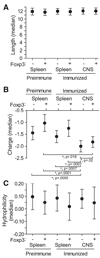T cell receptor CDR3 sequence but not recognition characteristics distinguish autoreactive effector and Foxp3(+) regulatory T cells
- PMID: 20005134
- PMCID: PMC2878844
- DOI: 10.1016/j.immuni.2009.09.023
T cell receptor CDR3 sequence but not recognition characteristics distinguish autoreactive effector and Foxp3(+) regulatory T cells
Abstract
The source, specificity, and plasticity of the forkhead box transcription factor 3 (Foxp3)(+) regulatory T (Treg) and conventional T (Tconv) cell populations active at sites of autoimmune pathology are not well characterized. To evaluate this, we combined global repertoire analyses and functional assessments of isolated T cell receptors (TCR) from TCRalpha retrogenic mice with autoimmune encephalomyelitis. Treg and Tconv cell TCR repertoires were distinct, and autoantigen-specific Treg and Tconv cells were enriched in diseased tissue. Autoantigen sensitivity and fine specificity of these cells intersected, implying that differences in responsiveness were not responsible for lineage specification. Notably, autoreactive Treg and Tconv cells could be fully distinguished by an acidic versus aliphatic variation at a single TCR CDR3 residue. Our results imply that ontogenically distinct Treg and Tconv cell repertoires with convergent specificities for autoantigen respond during autoimmunity and argue against more than limited plasticity between Treg and Tconv cells during autoimmune inflammation.
Copyright 2009 Elsevier Inc. All rights reserved.
Figures





Similar articles
-
Discrete TCR repertoires and CDR3 features distinguish effector and Foxp3+ regulatory T lymphocytes in myelin oligodendrocyte glycoprotein-induced experimental allergic encephalomyelitis.J Immunol. 2010 Oct 1;185(7):3895-904. doi: 10.4049/jimmunol.1001550. Epub 2010 Sep 1. J Immunol. 2010. PMID: 20810983 Free PMC article.
-
Thymus-Derived Regulatory T Cells Are Positively Selected on Natural Self-Antigen through Cognate Interactions of High Functional Avidity.Immunity. 2016 May 17;44(5):1114-26. doi: 10.1016/j.immuni.2016.04.018. Immunity. 2016. PMID: 27192577
-
Self-antigen-driven activation induces instability of regulatory T cells during an inflammatory autoimmune response.Immunity. 2013 Nov 14;39(5):949-62. doi: 10.1016/j.immuni.2013.10.016. Immunity. 2013. PMID: 24238343 Free PMC article.
-
The T-cell receptor repertoire of regulatory T cells.Immunology. 2008 Dec;125(4):450-8. doi: 10.1111/j.1365-2567.2008.02992.x. Immunology. 2008. PMID: 19128356 Free PMC article. Review.
-
Thymic commitment of regulatory T cells is a pathway of TCR-dependent selection that isolates repertoires undergoing positive or negative selection.Curr Top Microbiol Immunol. 2005;293:43-71. doi: 10.1007/3-540-27702-1_3. Curr Top Microbiol Immunol. 2005. PMID: 15981475 Review.
Cited by
-
Once a Treg, always a Treg?Immunol Rev. 2014 May;259(1):173-91. doi: 10.1111/imr.12173. Immunol Rev. 2014. PMID: 24712466 Free PMC article. Review.
-
Development of T-cell tolerance utilizes both cell-autonomous and cooperative presentation of self-antigen.Immunol Rev. 2016 May;271(1):141-55. doi: 10.1111/imr.12403. Immunol Rev. 2016. PMID: 27088912 Free PMC article. Review.
-
Conventional and Regulatory CD4+ T Cells That Share Identical TCRs Are Derived from Common Clones.PLoS One. 2016 Apr 21;11(4):e0153705. doi: 10.1371/journal.pone.0153705. eCollection 2016. PLoS One. 2016. PMID: 27100298 Free PMC article.
-
Regulatory T cells control diabetes without compromising acute anti-viral defense.Clin Immunol. 2014 Aug;153(2):298-307. doi: 10.1016/j.clim.2014.05.006. Epub 2014 May 22. Clin Immunol. 2014. PMID: 24858581 Free PMC article.
-
A temporal thymic selection switch and ligand binding kinetics constrain neonatal Foxp3+ Treg cell development.Nat Immunol. 2019 Aug;20(8):1046-1058. doi: 10.1038/s41590-019-0414-1. Epub 2019 Jun 17. Nat Immunol. 2019. PMID: 31209405 Free PMC article.
References
-
- Aifantis I, Mandal M, Sawai K, Ferrando A, Vilimas T. Regulation of T-cell progenitor survival and cell-cycle entry by the pre-T-cell receptor. Immunol. Rev. 2006;209:159–169. - PubMed
-
- Andersson J, Stefanova I, Stephens GL, Shevach EM. CD4+CD25+ regulatory T cells are activated in vivo by recognition of self. Int. Immunol. 2007;19:557–566. - PubMed
-
- Bailey SL, Schreiner B, McMahon EJ, Miller SD. CNS myeloid DCs presenting endogenous myelin peptides ‘preferentially’ polarize CD4+ T(H)−17 cells in relapsing EAE. Nat. Immunol. 2007;8:172–180. - PubMed
Publication types
MeSH terms
Substances
Grants and funding
LinkOut - more resources
Full Text Sources

